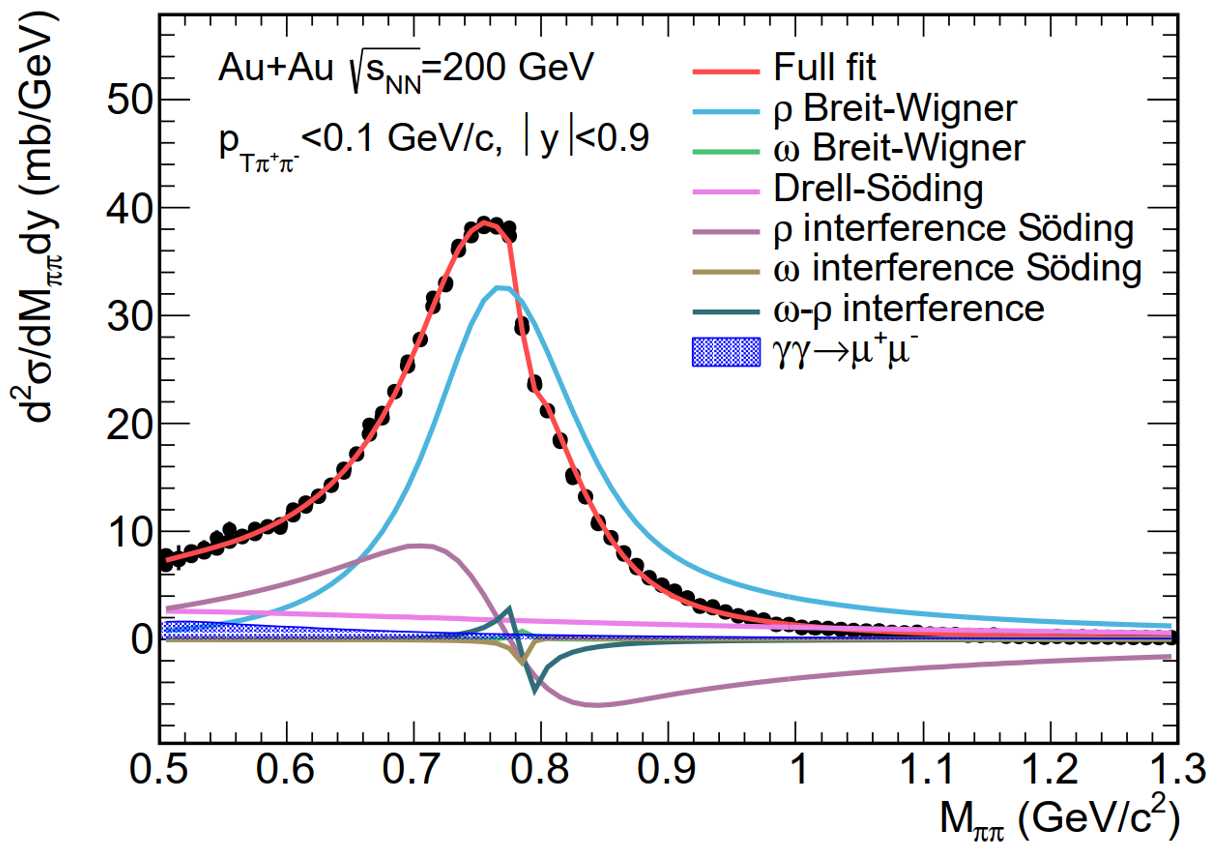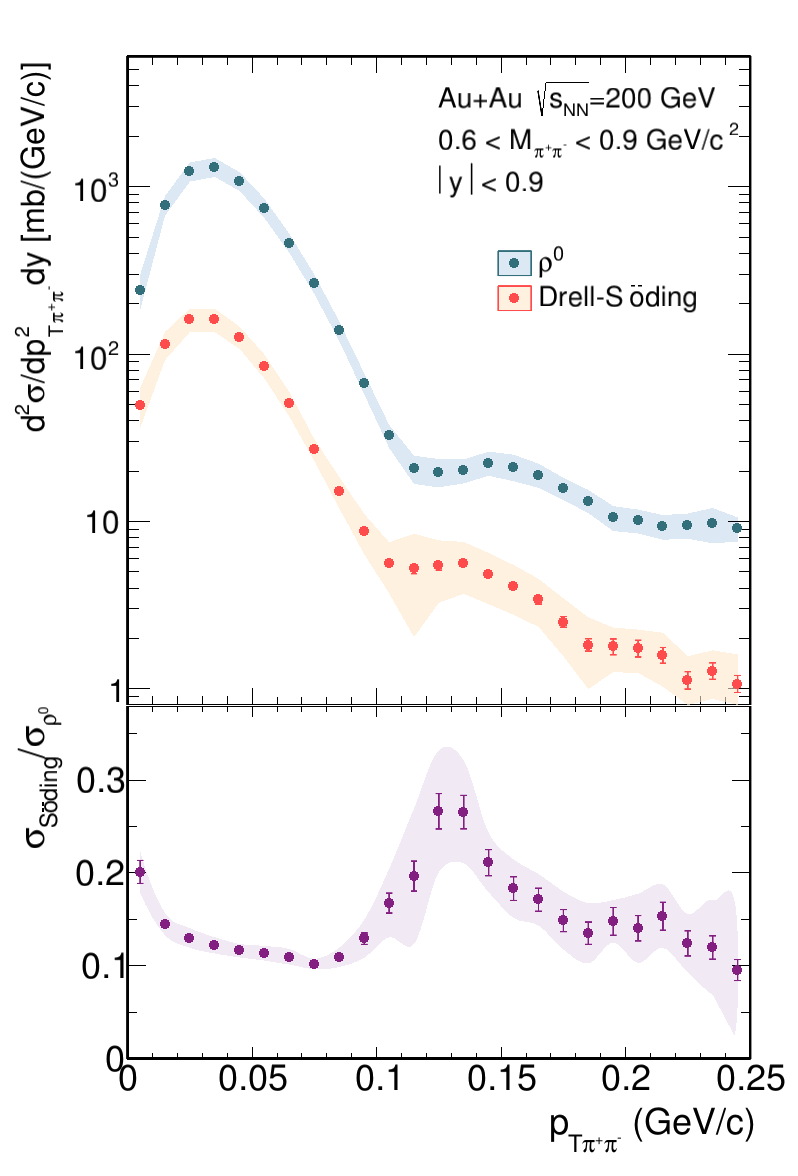Observation of the Spin-Interference in the Drell-Söding Process in Au+Au Ultraperipheral Collisions at RHIC
Target Journal: PRL
PA: Daniel Brandenburg, Sam Corey, Xinbai Li, Lijuan Ruan, Zebo Tang, Kaiyang Wang, Xin Wu, Zhangbu Xu, Chi Yang, Di Zhang, Wangmei Zha
Abstract
We report a measurement of the Drell-S${\rm \ddot{o}ding}$ $\pi^+ \pi^-$ production in Au $+$ Au ultrperipheral collisions at $\sqrt{s_{NN}}=200$ GeV using STAR detector. For the first time, the Entanglement Enabled Spin-Interference effect is observed in the Drell-S${\rm \ddot{o}ding}$ process through the amplitude of cosine modulation for the second harmonic ${\rm A_{2\Delta\phi}}$. The Drell-S${\rm \ddot{o}ding}$ process is found clearly softer than the $\rho^0$ photoproduction from the diffractive t spectrum mainly due to its production mechanism. The measured ${\rm A_{2\Delta\phi}}$ exhibit no significant dependence on mass $M_{\pi^+ \pi^-}$ and an enhancement with 5.3$\sigma$ for the Drell-S${\rm \ddot{o}ding}$ process compared to the $\rho^0$ photoproduction. For pair 0<p_T<0.1 GeV/c, $|y|<0.9$ and $0.6<M_{\pi^+\pi^-}<0.9$ GeV/$c^2$, the $A_{2\Delta\phi}$ is found to be $0.2731\pm0.0026\pm0.0109$ for the Drell-S${\rm \ddot{o}ding}$ process and $0.2186\pm0.0022\pm0.0046$ for $\rho^0$ photoproduction. The results provide new insights into the interplay between quantum interference and photon-nuclear interactions in ultra-peripheral heavy-ion collisions.
Figure 1 :Schematic View of the Production Mechanism for the Drell-Söding Process

Caption
Schematic view of the production mechanism for Drell-S${\rm \ddot{o}ding}$ process. A virtual photon fluctuates into an entangled $\pi^{+}\pi^{-}$ pair during strong interaction time ($\sim 2\times10^{-24}$s). One single virtual $\pi^{+}/\pi^{-}$ is diffraction-scattered on the nucleus. The wavy structures represent local energy fluctuation in the strong electromagnetic field, while the associated blue and red balls depict short-lived pair fluctuation due to the local energy excitation.
Figure 2 : Extraction of Drell-Söding

Caption
The differential cross section $d^2\sigma/dM_{\pi\pi}dy$ of exclusive $\pi^{+}\pi^{-}$ production for pair $p_T<0.1$ GeV/c and $|y|<0.9$ in Au+Au UPCs at $\sqrt{s_{NN}} = 200$~GeV and illustration of the fitting algorithm to separate resonance and continuum components. The black markers show the data, the lilac markers show the Drell-S${\rm \ddot{o}ding}$ term. The interference for $\rho$-Söding (purple), $\omega$-Söding (brown) and $\rho-\omega$ is shown. The $\mu^+\mu^-$ pair production is represented by the blue band.

Caption
(top) The differential cross section $d\sigma/dp_T^2dy$ of exclusive $\pi^{+}\pi^{-}$ production on $p_T$ dependence for pair $p_T<0.1$ GeV/c and $|y|<0.9$ in Au+Au UPCs at $\sqrt{s_{NN}} = 200$~GeV. The blue and red markers show $\rho^0$ photoproduction and Drell-S${\rm \ddot{o}ding}$ process respectively. (bottom) The ratio for the cross section of Drell-S${\rm \ddot{o}ding}$ to $\rho^0$ photoproduction, investigates the photon hadronic structure and a softer production mechanism.
Figure 4 : Spin interference pattern
.png)
Caption
The second order modulation amplitude $A_{2\Delta\phi}$ as functions of the pair transverse momentum $p_T$ (left) and the invariant mass $M_{\pi^+\pi^-}$ (right) for 0<p_T<0.1 GeV/c, $0.6<M_{\pi^+\pi^-}<0.9$ GeV/$c^2$ and $\vert y \vert<0.9$ in Au+Au UPC at $\sqrt{s_{NN}}=200$ GeV. The Drell-S${\rm \ddot{o}ding}$ process and $\rho^0$ photoproduction are shown in red and teal points. Statistic uncertainties and systematic uncertainties are represented by the error bars and boxes respectively. The model calculations are donated as dash lines.
Summary & Conclusions
- In conclusion, we report the observation of the spin-interference in Drell-S${\rm \ddot{o}ding}$ process and the differential cross section on pair $p_T$ and $M$ dependence for Drell-S${\rm \ddot{o}ding}$ process and $\rho^0$ photoproduction in Au+Au UPC at $\sqrt{s_{NN}}=200$ GeV at RHIC. A model based Drell-S${\rm \ddot{o}ding}$ shape is employed in separation of different processes involved in exclusive $\pi^+\pi^-$ production.
- The Drell-S${\rm \ddot{o}ding}$ process is observed obviously softer from the pair $p_T$ spectrum compared to $\rho^0$ photoproduction. The observation of spin-interference effect demonstrates that the non-resonant $\pi^+\pi^-$ pairs are entangled in the Drell-S${\rm \ddot{o}ding}$ process. The amplitude $A_{2\Delta\phi}$ for Drell-S${\rm \ddot{o}ding}$ process and $\rho^0$ photoproduction are found to have similar decrease trend along the pair $p_T$. While an enhancement is observed for Drell-S${\rm \ddot{o}ding}$ in pair 0.05<p_T<0.1 GeV/c compared to $\rho^0$. The measured $A_{2\Delta\phi}$ for these processes is found to have no obvious pair mass $M_{\pi^+\pi^-}$ dependence and the amplitude $A_{2\Delta\phi}$ for Drell-S${\rm \ddot{o}ding}$ is $5.3\sigma$ higher than $\rho^0$ photoproduction among the observed mass regions. A comprehensive analysis on the measurements is reported through the comparison between resonant and non-resonant $\pi^+\pi^-$ photoproduction. These results provide new insights into the interplay between quantum interference and photon-nuclear interactions in ultraperipheral heavy-ion collisions.
